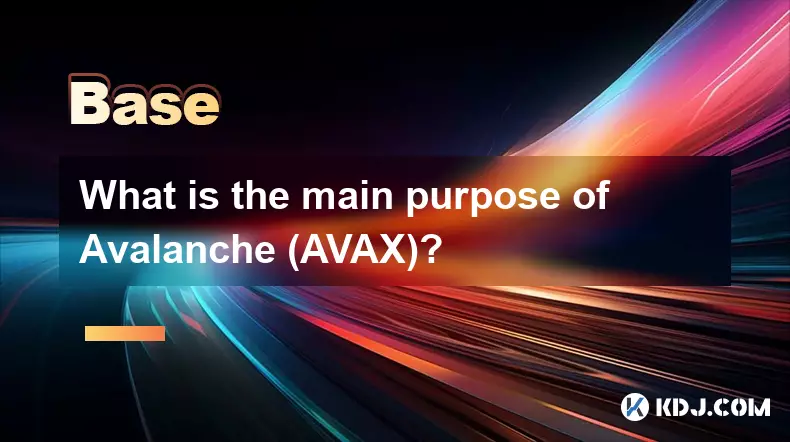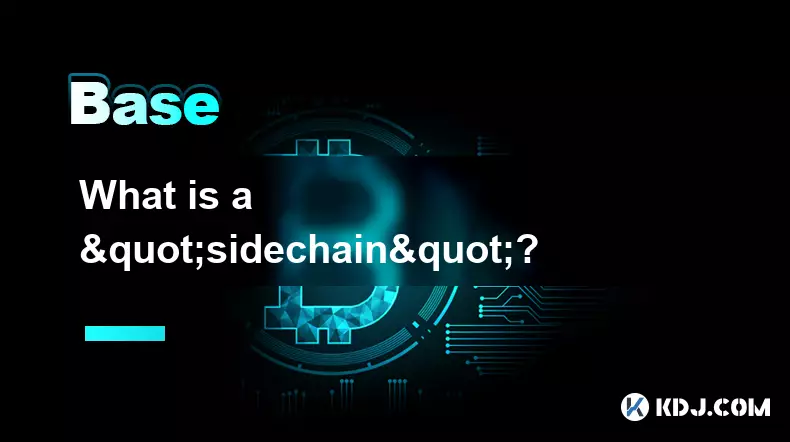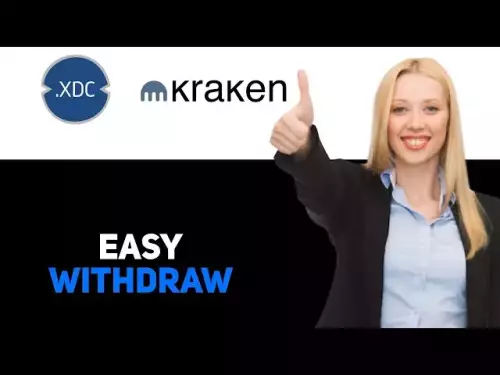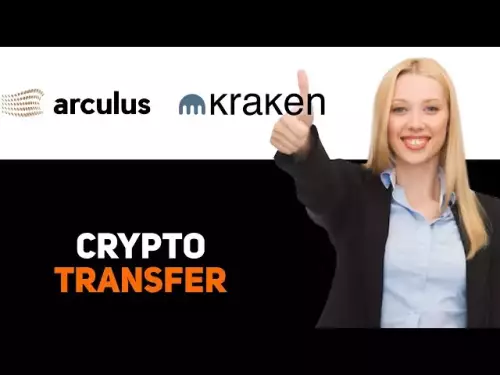-
 bitcoin
bitcoin $114684.631706 USD
-0.87% -
 ethereum
ethereum $4228.677447 USD
1.58% -
 bnb
bnb $1294.880693 USD
-1.16% -
 tether
tether $1.000819 USD
-0.02% -
 xrp
xrp $2.605138 USD
2.79% -
 solana
solana $209.908690 USD
5.89% -
 usd-coin
usd-coin $0.999903 USD
-0.03% -
 dogecoin
dogecoin $0.213423 USD
2.93% -
 tron
tron $0.322721 USD
-0.10% -
 cardano
cardano $0.727247 USD
3.66% -
 hyperliquid
hyperliquid $42.339456 USD
6.05% -
 chainlink
chainlink $19.910811 USD
5.16% -
 ethena-usde
ethena-usde $1.000557 USD
0.00% -
 stellar
stellar $0.349734 USD
2.69% -
 bitcoin-cash
bitcoin-cash $543.848687 USD
-0.21%
What is the main purpose of Avalanche (AVAX)?
Avalanche (AVAX) enables fast, secure, and scalable blockchain apps through its unique consensus, staking-based security, and customizable subnets.
Oct 12, 2025 at 11:04 pm

Main Purpose of Avalanche (AVAX)
1. The primary purpose of Avalanche (AVAX) is to enable fast, secure, and scalable blockchain applications by leveraging a unique consensus mechanism known as the Avalanche consensus protocol. This protocol allows transactions to be finalized in under one second, making it highly efficient compared to traditional proof-of-work systems.
2. AVAX serves as the native token of the Avalanche network, functioning as the backbone for transaction fees, staking, and governance. Users must pay fees in AVAX when deploying smart contracts or transferring assets across the platform, reinforcing its utility within the ecosystem.
3. One of the core goals of Avalanche is interoperability. The network supports multiple custom blockchains through its subnet architecture, allowing developers to create specialized environments tailored to specific use cases while remaining connected to the broader Avalanche ecosystem.
4. Scalability is a central focus. Unlike many other blockchains that face congestion during peak usage, Avalanche’s design enables thousands of transactions per second without sacrificing decentralization or security, positioning it as a strong competitor in the decentralized application space.
5. Decentralized finance (DeFi) thrives on Avalanche due to its low latency and minimal transaction costs. Numerous DeFi protocols have migrated or launched natively on Avalanche, attracted by its performance and developer-friendly tools, further solidifying AVAX’s role in powering next-generation financial applications.
Role of AVAX in Network Security
1. Validators on the Avalanche network are required to stake AVAX tokens to participate in consensus. This staking mechanism ensures that malicious actors would need to acquire a significant portion of the circulating supply to compromise the network, making attacks economically unfeasible.
2. When users delegate their AVAX to validators, they contribute to the overall security and stability of the network. In return, they earn rewards, creating an incentive structure that aligns participants with the long-term health of the platform.
3. The scarcity and fixed maximum supply of 720 million AVAX tokens enhance its value proposition. As demand for staking and transaction processing grows, the token's role in securing the network becomes increasingly critical.
4. Security on Avalanche is directly tied to the amount of AVAX staked across subnets and the main network. Higher staking levels increase resistance to double-spending and other forms of network manipulation.
5. The protocol automatically adjusts validator sets based on stake weight, ensuring dynamic participation and reducing the risk of centralization among a small group of nodes.
Support for Custom Blockchains and Subnets
1. Avalanche allows individuals and organizations to launch their own blockchains using the platform’s infrastructure. These blockchains operate as subnets—independent networks capable of defining their own rules, virtual machines, and validator requirements.
2. Each subnet can support multiple blockchains, enabling enterprises or communities to build ecosystems tailored to regulatory needs, performance demands, or niche applications such as gaming or identity management.
3. Subnets enhance scalability by isolating transaction load, preventing congestion on the primary chains like the C-Chain, X-Chain, and P-Chain.
4. Developers benefit from compatibility with Ethereum’s tooling on the C-Chain, allowing easy migration of existing dApps while also having the freedom to design entirely new architectures within dedicated subnets.
5. Projects such as Degenerate Ape Academy and various enterprise-grade platforms have utilized subnets to maintain control over governance and user experience while still benefiting from Avalanche’s speed and connectivity.
Integration with the Broader Crypto Ecosystem
1. Avalanche has established bridges to major blockchains including Ethereum and Bitcoin, facilitating cross-chain asset transfers. These bridges expand liquidity options and allow users to bring external assets into Avalanche-based DeFi protocols.
2. Partnerships with institutions and fintech companies have enabled real-world asset tokenization on Avalanche, such as bonds, commodities, and private equity, broadening its application beyond speculative trading.
3. The Avalanche Rush initiative incentivized top-tier DeFi projects like Aave and Curve to deploy on the network, significantly increasing total value locked and user engagement.
4. By supporting EVM compatibility, Avalanche lowers the barrier for developers already familiar with Solidity and Ethereum development workflows, accelerating adoption and innovation.
5. Ongoing integration with Layer 2 solutions and wallet providers ensures seamless access for retail and institutional users alike, reinforcing its position as a versatile blockchain platform.
Frequently Asked Questions
What makes Avalanche’s consensus different from Proof-of-Stake?Avalanche uses a novel consensus mechanism based on metastable voting, where nodes repeatedly sample peers to reach agreement. It achieves finality faster than traditional PoS systems and scales efficiently without requiring leader election or block proposers.
Can AVAX be used outside the Avalanche network?While AVAX is primarily used within the Avalanche ecosystem, it is listed on major exchanges and can be traded or held like any other cryptocurrency. Its utility remains strongest when interacting with Avalanche-based applications and services.
How does staking AVAX benefit the average user?Staking AVAX provides passive income through reward distributions. It also gives holders influence in network governance proposals, allowing them to vote on upgrades, parameter changes, and funding initiatives.
Are there risks associated with launching a subnet on Avalanche?Yes, operators must ensure sufficient validator participation and economic incentives to maintain security. Poorly capitalized subnets may be vulnerable to attacks if the cost of acquiring majority stake is too low.
Disclaimer:info@kdj.com
The information provided is not trading advice. kdj.com does not assume any responsibility for any investments made based on the information provided in this article. Cryptocurrencies are highly volatile and it is highly recommended that you invest with caution after thorough research!
If you believe that the content used on this website infringes your copyright, please contact us immediately (info@kdj.com) and we will delete it promptly.
- XRP Price Prediction: Weekend Rollercoaster or Rally?
- 2025-10-12 08:45:16
- Bittensor (TAO): Super Bullish Signals Point to Potential 2x Rally
- 2025-10-11 10:25:12
- Silver Price Correction: Navigating the Dip & Identifying Key SEO Keywords
- 2025-10-11 10:25:12
- Decoding Crypto Trends: Bittensor's Bull Run, Cardano's Dip, and LivLive's Presale Buzz in 'Uptober 2025'
- 2025-10-12 08:45:16
- MoonBull: The Crypto Meme Coin Promising 1000x Gains?
- 2025-10-11 10:30:01
- Crypto Payroll Revolution: Stablecoins, Altcoins, and the Future of Salary Payments
- 2025-10-11 10:30:01
Related knowledge

How do decentralized identity (DID) solutions work?
Oct 14,2025 at 11:36pm
Understanding Decentralized Identity in the Blockchain Ecosystem1. Decentralized identity (DID) solutions are built on blockchain networks, allowing i...

What does it mean for code to be "open source" in crypto?
Oct 12,2025 at 01:54pm
Understanding Open Source in the Cryptocurrency Ecosystem1. In the context of cryptocurrency, open source refers to software whose code is publicly ac...

What is the purpose of a "testnet"?
Oct 12,2025 at 09:01am
Understanding the Role of Testnets in Blockchain Development1. A testnet serves as a parallel version of a blockchain network, designed specifically f...

How to avoid phishing scams in crypto?
Oct 13,2025 at 06:18pm
Understanding Common Crypto Phishing Tactics1. Cybercriminals frequently use fake websites that mirror legitimate crypto exchanges or wallet platforms...

What is the difference between single-collateral and multi-collateral Dai?
Oct 12,2025 at 05:18pm
Understanding Single-Collateral Dai1. Single-Collateral Dai (SCD) was the original version of the Dai stablecoin launched by MakerDAO in 2017. It allo...

What is a "sidechain"?
Oct 13,2025 at 02:36pm
Understanding the Concept of Sidechains1. A sidechain is a blockchain that operates independently but is connected to another blockchain, known as the...

How do decentralized identity (DID) solutions work?
Oct 14,2025 at 11:36pm
Understanding Decentralized Identity in the Blockchain Ecosystem1. Decentralized identity (DID) solutions are built on blockchain networks, allowing i...

What does it mean for code to be "open source" in crypto?
Oct 12,2025 at 01:54pm
Understanding Open Source in the Cryptocurrency Ecosystem1. In the context of cryptocurrency, open source refers to software whose code is publicly ac...

What is the purpose of a "testnet"?
Oct 12,2025 at 09:01am
Understanding the Role of Testnets in Blockchain Development1. A testnet serves as a parallel version of a blockchain network, designed specifically f...

How to avoid phishing scams in crypto?
Oct 13,2025 at 06:18pm
Understanding Common Crypto Phishing Tactics1. Cybercriminals frequently use fake websites that mirror legitimate crypto exchanges or wallet platforms...

What is the difference between single-collateral and multi-collateral Dai?
Oct 12,2025 at 05:18pm
Understanding Single-Collateral Dai1. Single-Collateral Dai (SCD) was the original version of the Dai stablecoin launched by MakerDAO in 2017. It allo...

What is a "sidechain"?
Oct 13,2025 at 02:36pm
Understanding the Concept of Sidechains1. A sidechain is a blockchain that operates independently but is connected to another blockchain, known as the...
See all articles

























![[4K 60fps] Prisma by novichokk (1 Coin) [4K 60fps] Prisma by novichokk (1 Coin)](/uploads/2025/10/14/cryptocurrencies-news/videos/k-fps-prisma-novichokk-coin/68ee49804ba00_image_500_375.webp)
















































